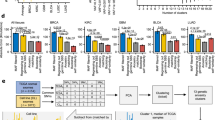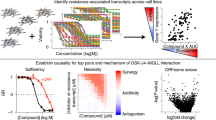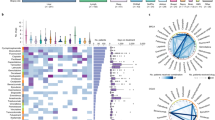Abstract
Clinical responses to anticancer therapies are often restricted to a subset of patients. In some cases, mutated cancer genes are potent biomarkers for responses to targeted agents. Here, to uncover new biomarkers of sensitivity and resistance to cancer therapeutics, we screened a panel of several hundred cancer cell lines—which represent much of the tissue-type and genetic diversity of human cancers—with 130 drugs under clinical and preclinical investigation. In aggregate, we found that mutated cancer genes were associated with cellular response to most currently available cancer drugs. Classic oncogene addiction paradigms were modified by additional tissue-specific or expression biomarkers, and some frequently mutated genes were associated with sensitivity to a broad range of therapeutic agents. Unexpected relationships were revealed, including the marked sensitivity of Ewing’s sarcoma cells harbouring the EWS (also known as EWSR1)-FLI1 gene translocation to poly(ADP-ribose) polymerase (PARP) inhibitors. By linking drug activity to the functional complexity of cancer genomes, systematic pharmacogenomic profiling in cancer cell lines provides a powerful biomarker discovery platform to guide rational cancer therapeutic strategies.
This is a preview of subscription content, access via your institution
Access options
Subscribe to this journal
Receive 51 print issues and online access
$199.00 per year
only $3.90 per issue
Buy this article
- Purchase on Springer Link
- Instant access to full article PDF
Prices may be subject to local taxes which are calculated during checkout




Similar content being viewed by others
References
Druker, B. J. et al. Five-year follow-up of patients receiving imatinib for chronic myeloid leukemia. N. Engl. J. Med. 355, 2408–2417 (2006)
Kwak, E. L. et al. Anaplastic lymphoma kinase inhibition in non-small-cell lung cancer. N. Engl. J. Med. 363, 1693–1703 (2010)
Chapman, P. B. et al. Improved survival with vemurafenib in melanoma with BRAF V600E mutation. N. Engl. J. Med. 364, 2507–2516 (2011)
McDermott, U. & Settleman, J. Personalized cancer therapy with selective kinase inhibitors: an emerging paradigm in medical oncology. J. Clin. Oncol. 27, 5650–5659 (2009)
Shoemaker, R. H. et al. Development of human tumor cell line panels for use in disease-oriented drug screening. Prog. Clin. Biol. Res. 276, 265–286 (1988)
Weinstein, J. N. et al. An information-intensive approach to the molecular pharmacology of cancer. Science 275, 343–349 (1997)
McDermott, U. et al. Identification of genotype-correlated sensitivity to selective kinase inhibitors by using high-throughput tumor cell line profiling. Proc. Natl Acad. Sci. USA 104, 19936–19941 (2007)
Suwaki, N. et al. A HIF-regulated VHL-PTP1B-Src signaling axis identifies a therapeutic target in renal cell carcinoma. Sci. Transl. Med. 3, 85ra47 (2011)
Deng, L. et al. Rho-kinase inhibitor, fasudil, suppresses glioblastoma cell line progression in vitro and in vivo. Cancer Biol. Ther. 9, 875–884 (2010)
Weber, D. M. et al. Lenalidomide plus dexamethasone for relapsed multiple myeloma in North America. N. Engl. J. Med. 357, 2133–2142 (2007)
Konecny, G. E. et al. Activity of the dual kinase inhibitor lapatinib (GW572016) against HER-2-overexpressing and trastuzumab-treated breast cancer cells. Cancer Res. 66, 1630–1639 (2006)
Lynch, T. J. et al. Activating mutations in the epidermal growth factor receptor underlying responsiveness of non-small-cell lung cancer to gefitinib. N. Engl. J. Med. 350, 2129–2139 (2004)
O’Farrell, A. M. et al. SU11248 is a novel FLT3 tyrosine kinase inhibitor with potent activity in vitro and in vivo. Blood 101, 3597–3605 (2003)
Kunii, K. et al. FGFR2-amplified gastric cancer cell lines require FGFR2 and Erbb3 signaling for growth and survival. Cancer Res. 68, 2340–2348 (2008)
Byron, S. A. et al. Inhibition of activated fibroblast growth factor receptor 2 in endometrial cancer cells induces cell death despite PTEN abrogation. Cancer Res. 68, 6902–6907 (2008)
Vassilev, L. T. et al. In vivo activation of the p53 pathway by small-molecule antagonists of MDM2. Science 303, 844–848 (2004)
Konecny, G. E. et al. Expression of p16 and retinoblastoma determines response to CDK4/6 inhibition in ovarian cancer. Clin. Cancer Res. 17, 1591–1602 (2011)
Boisvert-Adamo, K., Longmate, W., Abel, E. V. & Aplin, A. E. Mcl-1 is required for melanoma cell resistance to anoikis. Mol. Cancer Res. 7, 549–556 (2009)
Brown, C. J., Lain, S., Verma, C. S., Fersht, A. R. & Lane, D. P. Awakening guardian angels: drugging the p53 pathway. Nature Rev. Cancer 9, 862–873 (2009)
Zou, H. & Hastie, T. Regularization and variable selection via the elastic net. J. R. Stat. Soc. B 67, 301–320 (2005)
Hanafusa, H., Torii, S., Yasunaga, T. & Nishida, E. Sprouty1 and Sprouty2 provide a control mechanism for the Ras/MAPK signalling pathway. Nature Cell Biol. 4, 850–858 (2002)
Patterson, K. I., Brummer, T., O’Brien, P. M. & Daly, R. J. Dual-specificity phosphatases: critical regulators with diverse cellular targets. Biochem. J. 418, 475–489 (2009)
Dry, J. R. et al. Transcriptional pathway signatures predict MEK addiction and response to selumetinib (AZD6244). Cancer Res. 70, 2264–2273 (2010)
Kelland, L. R., Sharp, S. Y., Rogers, P. M., Myers, T. G. & Workman, P. DT-Diaphorase expression and tumor cell sensitivity to 17-allylamino,17-demethoxygeldanamycin, an inhibitor of heat shock protein 90. J. Natl Cancer Inst. 91, 1940–1949 (1999)
Fong, P. C. et al. Inhibition of poly(ADP-ribose) polymerase in tumors from BRCA mutation carriers. N. Engl. J. Med. 361, 123–134 (2009)
McCabe, N. et al. BRCA2-deficient CAPAN-1 cells are extremely sensitive to the inhibition of poly (ADP-ribose) polymerase: an issue of potency. Cancer Biol. Ther. 4, 934–936 (2005)
Riggi, N. et al. Development of Ewing’s sarcoma from primary bone marrow-derived mesenchymal progenitor cells. Cancer Res. 65, 11459–11468 (2005)
Riggi, N. et al. Expression of the FUS-CHOP fusion protein in primary mesenchymal progenitor cells gives rise to a model of myxoid liposarcoma. Cancer Res. 66, 7016–7023 (2006)
Brenner, J. C. et al. Mechanistic rationale for inhibition of poly(ADP-ribose) polymerase in ETS gene fusion-positive prostate cancer. Cancer Cell 19, 664–678 (2011)
Balamuth, N. J. & Womer, R. B. Ewing’s sarcoma. Lancet Oncol. 11, 184–192 (2010)
Barretina, J. et al. The Cancer Cell Line Encyclopedia enables predictive modelling of anticancer drug sensitivity. Naturehttp://dx.doi.org/10.1038/nature11003 (this issue)
Prieur, A., Tirode, F., Cohen, P. & Delattre, O. EWS/FLI-1 silencing and gene profiling of Ewing cells reveal downstream oncogenic pathways and a crucial role for repression of insulin-like growth factor binding protein 3. Mol. Cell. Biol. 24, 7275–7283 (2004)
Boland, C. R. et al. A National Cancer Institute Workshop on microsatellite instability for cancer detection and familial predisposition: development of international criteria for the determination of microsatellite instability in colorectal cancer. Cancer Res. 58, 5248–5257 (1998)
Greenman, C. D. et al. PICNIC: an algorithm to predict absolute allelic copy number variation with microarray cancer data. Biostatistics 11, 164–175 (2010)
Bolstad, B. M., Irizarry, R. A., Astrand, M. & Speed, T. P. A comparison of normalization methods for high density oligonucleotide array data based on variance and bias. Bioinformatics 19, 185–193 (2003)
Frey, B. J. & Dueck, D. Clustering by passing messages between data points. Science 315, 972–976 (2007)
Iorio, F. et al. Discovery of drug mode of action and drug repositioning from transcriptional responses. Proc. Natl Acad. Sci. USA 107, 14621–14626 (2010)
Shannon, P. et al. Cytoscape: a software environment for integrated models of biomolecular interaction networks. Genome Res. 13, 2498–2504 (2003)
Acknowledgements
We thank P. Lo Grasso of the Scripps Research Institute for providing the inhibitor JNK9L. This work was supported by a grant from the Wellcome Trust (086357; M.R.S., P.A.F., J.S., D.A.H.) and by grants from the National Institutes of Health (P41GM079575-02 to N.S.G. and 1U54HG006097-01 to N.S.G. and D.A.H.). S.R. is supported by a Physician-Scientist Early Career Award from the Howard Hughes Medical Institute. U.M. is supported by a Cancer Research UK Clinician Scientist Fellowship.
Author information
Authors and Affiliations
Contributions
M.J.G., C.H.B., U.M. and S.V.S. supervised data collection. M.J.G., C.H.B., U.M. and S.R. supervised data analysis. C.D.G. and K.W.L. conceived and wrote the curve-fitting algorithm and performed the MANOVA; E.J.E. and S.R. performed elastic net analysis and analysed the data. P.G., I.R.T. and J.So. developed and managed screening databases with assistance from A.B. and W.Y.; S.J.H. performed most of the Ewing’s sarcoma related studies with contributions from D.S., A.D., X.L., F.K. and L.C., with I.S. and O.D. providing critical reagents; R.J.M., A.T.T., J.A.S., S.B., S.R.L., K.L., A.M.-D., J.L.B., X.M., T.M., H.T., L.R., F.J. and P.O’B. performed cell line screening experiments. S.P. performed MCL1 siRNA experiments. Q.L.,W.Z., T.Z., W.H., X.D., H.G.C. and J.W.C. synthesized screening compounds, and N.S.G. provided guidance on their selection and use; F.I. and J.S.-R. performed compound activity clustering; G.R.B. and H.D. performed cell line genotyping and genetic analysis; J.A.E. and J.B. provided guidance regarding clinical relevance of the work; M.J.G. and C.H.B. wrote the manuscript with major contributions from S.R., S.J.H. and U.M.; M.R.S., D.A.H., J.Se. and P.A.F. conceived the study, analysed the data and edited the manuscript.
Corresponding authors
Ethics declarations
Competing interests
J.Se. is currently an employee of Genentech and is a shareholder of Roche.
Supplementary information
Supplementary Information
This file contains Supplementary Figures 1-22 and Supplementary Tables 1-3. (PDF 6338 kb)
Supplementary Data
This file contains Supplementary Data 1-11. This file was replaced on 13 April 2012, as the original file posted on line had corrupted, and some of the data was missing from tables 1 and 11. (ZIP 13116 kb)
Rights and permissions
About this article
Cite this article
Garnett, M., Edelman, E., Heidorn, S. et al. Systematic identification of genomic markers of drug sensitivity in cancer cells. Nature 483, 570–575 (2012). https://doi.org/10.1038/nature11005
Received:
Accepted:
Published:
Issue Date:
DOI: https://doi.org/10.1038/nature11005
This article is cited by
-
The search for CDK4/6 inhibitor biomarkers has been hampered by inappropriate proliferation assays
npj Breast Cancer (2024)
-
A deep learning model of tumor cell architecture elucidates response and resistance to CDK4/6 inhibitors
Nature Cancer (2024)
-
Robust scoring of selective drug responses for patient-tailored therapy selection
Nature Protocols (2024)
-
Performance evaluation of drug synergy datasets using computational intelligence approaches
Multimedia Tools and Applications (2024)
-
The potential of PARP as a therapeutic target across pediatric solid malignancies
BMC Cancer (2023)
Comments
By submitting a comment you agree to abide by our Terms and Community Guidelines. If you find something abusive or that does not comply with our terms or guidelines please flag it as inappropriate.



